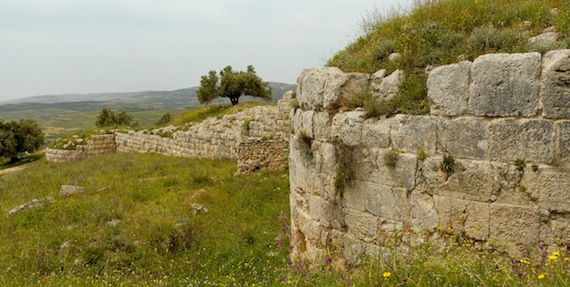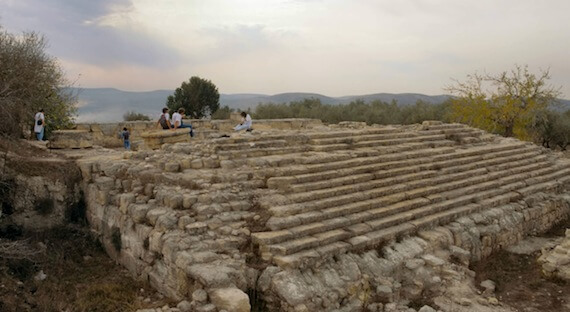I stood on the crumblings of an Iron Age acropolis with a valley all around the isolated hill. Cool breezes offset the summer heat, but its haze still obscured the western hills toward the Mediterranean.

(Photo: Hellenistic Roman fortifications at Samaria, courtesy of the Pictorial Library of Bible Lands)
The final capital stood beneath my feet, rising three hundred feet above the valley floor.
Its silent, crumbling ruins screamed a truth as timeless as it was timely.
The Roaming Capital Finally Settled
After King Solomon’s death, the nation Israel divided north of the Tribe of Benjamin’s border. Jerusalem stayed the capital in the south.
- Jeroboam chose Shechem as the capital for the Northern Kingdom, perhaps because of the significant history there for Ephraim’s tribe. Or maybe because Shechem had great spiritual significance for Abraham, Jacob, Joseph, and Joshua. Or possibly because Shechem lay along an essential crossroads along the Way of the Patriarchs.
- But the capital wasn’t there for long. Succeeding kings relocated Israel’s principal city from Shechem (to Penuel) to Tirzah.
- When King Omri moved the capital finally to Samaria, the capital stayed put, and the nation enjoyed its heyday.
Samaria served as the northern kingdom’s administrative center for 160 years. Samaria took it name from Shemer, the man who sold Omri the hill (1 Kings 16:24-28).
[slideshow id=22]
(All pics courtesy of the Pictorial Library of Bible Lands)
Samaria’s Prime Location
I only had to stand atop Tel Samaria to see why Omri selected it. This place, it seemed, could almost defend itself.
- The high hill had steep slopes all around and could accommodate as many as 40,000 citizens. In years to come the city expanded to 150 acres.
- Virtually impregnable during times of siege, the city could hold out until its cisterns went dry—its only supply of water. Although this proved a major drawback in times of siege, the city withstood the onslaught of the Arameans, Assyrians, and Hasmoneans for years at a time.
- Samaria enjoyed much produce from the nearby fertile valleys.
- Trade proved better in Samaria than in any other of the previous capitals, perhaps because it lay only about five miles off the International Highway and along a major road to Shechem.
on my upcoming trip to Israel.
See the details, browse the tour itinerary, and
download a FREE brochure! After your journey to Israel,
you will never be the same!
The peaceful and beautiful surroundings of Tel Samaria have a stark contrast to its history. I could almost catch the echoes of the bloody past that raged there.
- At Samaria, Ahab’s blood was washed from his chariot (1 Kings 20).
- It was here that Jezebel killed the prophets of God, and later, where Jehu killed the prophets of Baal (1 Kings 18:13; 2 Kings 10:17).
A Prosperous Failure
Although Jeroboam II gave Samaria its heyday of success, God called it a failure. The Prophet Amos spoke against the godless leaders:
Woe to those who are at ease in Zion, and to those who feel secure in the mountain of Samaria . . . those who recline on beds of ivory . . . Therefore, they will now go into exile at the head of the exiles. —Amos 6:1, 4, 7
Some of the carved ivory pieces Amos mentioned appear on display in today’s Rockefeller Museum in Jerusalem. They represent a prosperity that came at the price of a compromised relationship with God. As a result, Israel went into exile.
Samaria, Samaritans, and Herod the Great
After the Assyrians dragged the Northern Kingdom into exile in 722 BC, they repopulated the area, producing a mixed breed—partly Jewish, partly Assyrian—called Samaritans. When Alexander the Great placed some Macedonians at Samaria, the religious Samaritans relocated to nearby Mount Gerizim.
Caesar Augustus gave Samaria to Herod the Great, who rebuilt the city to his usual exorbitant standards and renamed the site Sebaste, the Greek name for Augustus.
- Herod the Great married Mariamne here but later killed her.
- Herod strangled his sons in Samaria.
- Some traditions hold that Samaria was also the place of John the Baptist’s execution (but it wasn’t).

(Photo: the Acropolis and Herodian temple steps, courtesy of the Pictorial Library of Bible Lands)
Echoes from Samaria
As I stood on the acropolis, I could see in one glance the crumbling ruins that represented hundreds of years of history.
- The place where the glorious kings of Israel made their palaces was largely destroyed as Herod the Great erected his obsequious temple to Caesar.
- The large steps leading to the top of the temple reflect a second-century repair job.
- All around the tell I saw ruins of various eras: Israelite walls, a basilica, a Roman theater, Hellenistic round towers, Herodian stylobates—and more.
Like so many great cities of yesteryear, Tel Samaria remains a testimony of all earthly glory.
The only beauty that remains is what God put there to begin with.
In my next post, I’ll share a devotional thought from Samaria.
Tell me what you think: What can the crumbling ruins of the most powerful cities in history teach us about what’s important? To leave a comment, just click here.
